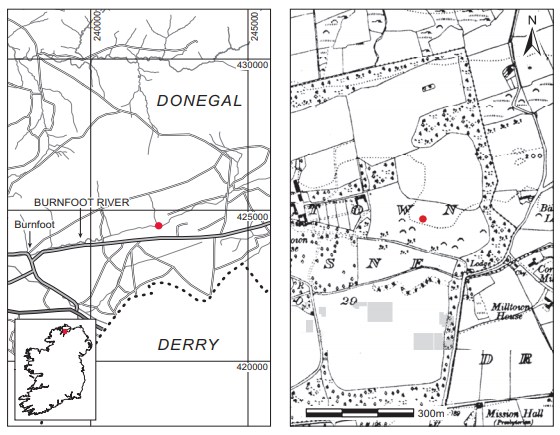1950:019 - BIRDSTOWN DEMESNE AND DRUMHAGGART, CO. DONEGAL, Donegal
County: Donegal
Site name: BIRDSTOWN DEMESNE AND DRUMHAGGART, CO. DONEGAL
Sites and Monuments Record No.: SMR DG038-031Drumhaggart, parish of Burt, barony of Inishowen West. SMR DG039-012
Licence number: —
Author: MARY CAHILL
Author/Organisation Address: —
Site type: Early Bronze Age graves
Period/Dating: —
ITM: E 641480m, N 924740m
Latitude, Longitude (decimal degrees): 55.068404, -7.350585
Introduction
Since the 1950s there have been reports of the discovery of a number of cists, cremated bone and other objects during the course of sand and gravel extraction in the adjoining townlands of Birdstown Demesne and Drumhaggart, Co. Donegal. None of these discoveries has been investigated by an archaeologist. The early finds, for which details are very scarce, have been published by Waddell (1990, 71–2; Drumhaggart) and Lacey (1983, 64–5, no. 300, Drumhaggart, and no. 285, Birdstown39). This note is to record two more recent reports of discoveries at this site in order to complete the record to date.
Location
The sites were in the townlands of Birdstown Demesne and Drumhaggart respectively in the south-east of the Inishowen peninsula.40
Birdstown Demesne41 (Fig. 3.23)
In 1982, through the good offices of Ms Claire Foley, DOENI,42 the NMI received some sherds of pottery and a very small quantity of cremated bone said to have been found some years previously in a cist. According to the report on file, the finds had been reburied at

the time, rediscovered about 1982 and re-excavated. The sherds (1982:119) are from an urn, but as they are undecorated and no rim sherds survive it is not possible to say what type of urn they represent. The human bone (1982:120) from this site has not been examined.
Drumhaggart43 (Fig. 3.24)
The first report dates from 1950, when six cists containing cremated remains were found. One of the cists also contained an undecorated biconical miniature vessel (1956:428). This site was not inspected by NMI staff and the only report extant is that written by Garda B. McTernan. Ó Donnabháin and Brindley (1989–90, 19–21) reported that the bones associated with the miniature vessel were those of a young adult female. A piece of unburnt antler was also found. The human remains have not been dated. Brindley (2007, 294) suggests that biconical miniature vessels date from c. 1900–1800 BC.
In late November 1998 Mr Brian McNaught and a colleague, both active archaeological field-walkers in north Donegal, noticed the remains of a pit burial on the face of the quarry at Drumhaggart. They collected a quantity of human bone and some pottery. An account of the discovery was published (McNaught 1999).
When the site was reported to the NMI an inspection by a local archaeologist was arranged, but the quarrying had recommenced and the site could not be located. In September 1999 the site was visited by Andrew Halpin, NMI, who examined the site44 and the nearby dump of soil. No trace of the original pit could be identified, but a large slab close by suggests that the grave may have been a slab-covered pit. Some fragments of cremated bone were found in the spoil.


The sherds of the vessel found in 1998 are part of a fragmentary bipartite bowl (Fig. 3.25) (1999:328), the large number of sherds representing a substantial part of the vessel. The complete vessel was c. 16cm high and c. 17cm in diameter and was decorated with panels of lines, both comb- and tooth-impressed, and false relief. The human remains from this burial have not been examined or dated.
Comment
Reports of discoveries from the quarrying activities in the adjoining townlands of Birdstown Demesne and Drumhaggart over a period of almost 50 years suggest that an early Bronze Age dispersed cemetery along the line of the sand and gravel deposits has been exposed on several occasions.
39. Based on a local report but with no details.
40. Birdstown Demesne, parish of Fahan Upper, barony of Inishowen West. SMR DG038-031——. IGR 241537 424755. Drumhaggart, parish of Burt, barony of Inishowen West. SMR DG039-012——. IGR 242166 424487.
41. OS 6in. sheet 38, 83.2cm E, 19.5cm N. These coordinates should be considered as an indication of the area in which the cist was found as it has not been possible to verify the location on the ground.
42. Department of the Environment, Northern Ireland.
43. OS 6in. sheet 39. The coordinates recorded are 15.00cm E and 16.70cm N. These coordinates would place the site in the adjoining townland of Soppoge, but the reports on file, including reports from An Garda Síochána, clearly state that the quarrying was taking place in Drumhaggart townland. It is assumed that the correct figure is either 1.5cm or 0.15cm, as this would place the 1950 discoveries very close to the most recent discoveries in 1998. The SMR records this site as a flat cemetery (DG039-012——).
44. OS 6in. sheet 39, IGR 242040 424502, placing the site just west of the main cemetery; see note 43 above. The inference is that this cemetery was spread across a broad area.
